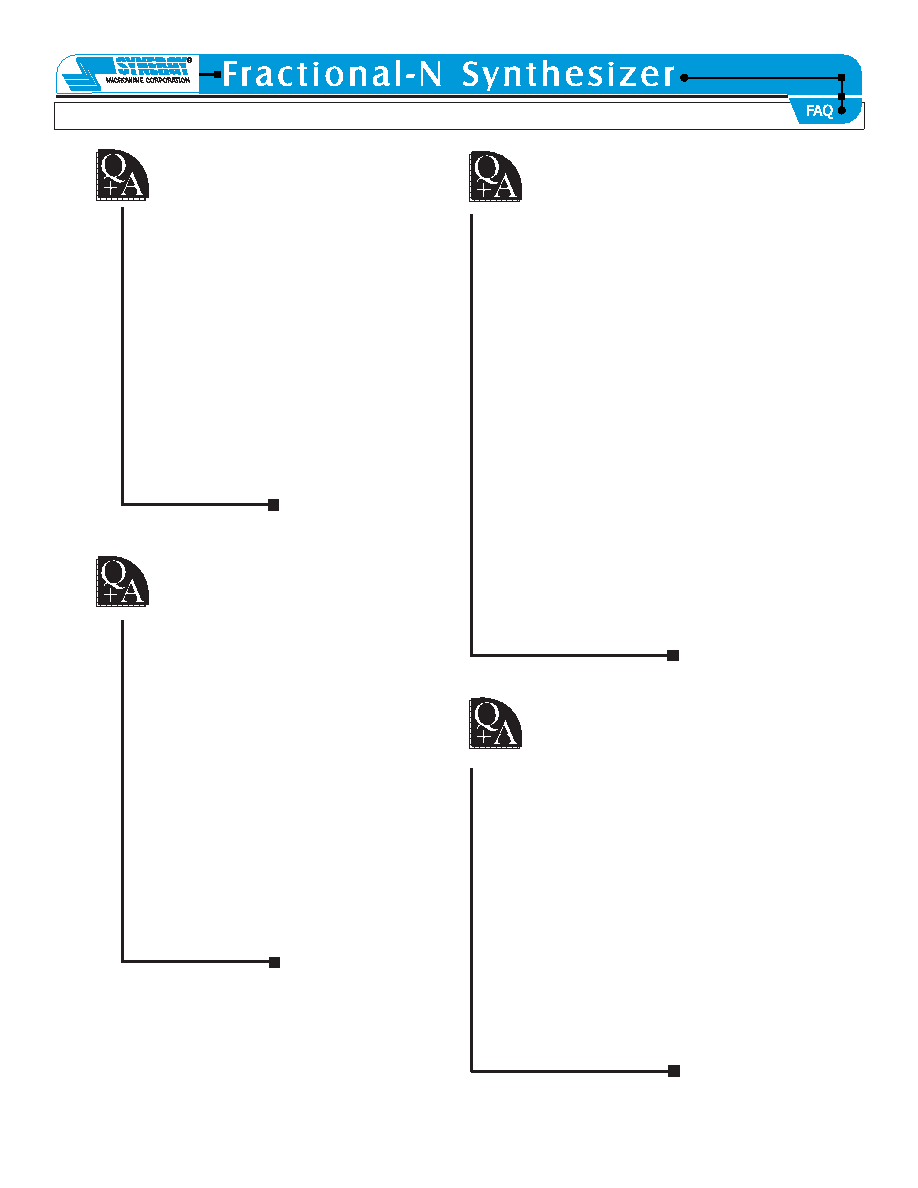- 您現(xiàn)在的位置:買賣IC網(wǎng) > PDF目錄68995 > FN3000-810-830 PLL FREQUENCY SYNTHESIZER, DMA37 PDF資料下載
參數(shù)資料
| 型號: | FN3000-810-830 |
| 元件分類: | PLL合成/DDS/VCOs |
| 英文描述: | PLL FREQUENCY SYNTHESIZER, DMA37 |
| 文件頁數(shù): | 2/12頁 |
| 文件大?。?/td> | 702K |
| 代理商: | FN3000-810-830 |

123456789012345678901234567890121234567890123456789012345678901212345678901234567890123456789012123456789012345678901234567890121234567890123456789012345678901212
201 McLean Blvd, Paterson, NJ 07504 Tel: (973) 881-8800 Fax: (973) 881-8361
E-mail: sales@synergymwave.com Web Site: http://www.synergymwave.com
[ 179 ]
Question: What is the difference between
a conventional one-loop synthesizer and
the fractional-N synthesizer?
Answer: The step size of a conventional
synthesizer is equal to the reference
frequency applied to the phase/frequency
discriminator. In a fractional-division
synthesizer, clever mathematical averag-
ing inside the chip allows quasi-arbitrary
frequency resolution compared to the
reference frequency.
Question: What phase-noise improve-
ment does the fractional-division synthe-
sizer provide?
Answer: Given a single-loop synthesizer
with 200-kHz reference and comparing this
to a fractional synthesizer with a reference
of 20 MHz, we automatically get a 40-dB
improvement inside the loop bandwidth.
Outside the loop bandwidth, the system
reproduces the phase noise of the oscilla-
tor. The improvement achieved is 20 log
(f
out/fref
), where f
out is the VCO output
frequency and f
ref
is the reference fre-
quency.
Question: Why does Synergy Microwave
recommend a reference frequency of
120 MHz?
Answer: The actual reference frequency
derived from the reference standard in the
Synergy fractional-N-division synthesizer is
based on the output frequency selected. We
have determined that a 120-MHz crystal
reference standard, divided down to a refer-
ence frequency that is selected by the intelli-
gent system, gives the best spurious re-
sponse. This mechanism, which changes
the actual reference frequency as a function
of the output frequency, minimizes spurious
signals at the output. To get a wide range of
the highest possible reference frequencies, it
is desirable to use a high-frequency reference
standard that on one hand is stable, and on
the other hand has the best phase noise.
Question: How does the reference standard
influence the phase noise?
Answer: We have found that a 120-MHz
reference standard gives the most universal
application and best phase-noise perfor-
mance. Since the most common industry-
standard reference frequencies are 10, 15,
and 20 MHz, the optional evaluation board
includes a means of locking its 120-MHz
crystal oscillator to the signal from an external
oscillator operating on one of these frequen-
cies. The evaluation-board crystal oscillator
then serves as the reference standard for the
synthesizer.
相關(guān)PDF資料 |
PDF描述 |
|---|---|
| FNA41060 | AC MOTOR CONTROLLER, DMA26 |
| FNB41560 | AC MOTOR CONTROLLER, DMA26 |
| FNW500R4 | 1-OUTPUT 504 W DC-DC REG PWR SUPPLY MODULE |
| FNW500R64-18 | 1-OUTPUT 504 W DC-DC REG PWR SUPPLY MODULE |
| FNW700R4 | 1-OUTPUT 700 W DC-DC REG PWR SUPPLY MODULE |
相關(guān)代理商/技術(shù)參數(shù) |
參數(shù)描述 |
|---|---|
| FN-300-50 | 制造商:TE Connectivity 功能描述:SHUNT; Current Rating:300A; Sensing Element:Copper Alloy; Operating Temperature Min:-20C; Operating Temperature Max:60C; Accuracy: 0.25%; Mounting Type:Base; Operating Temperature Range:-20C to +60C; Output Voltage:50mV ;RoHS Compliant: NA |
| FN3025HL-10-71 | 功能描述:電源線濾波器 ADV EMC/RFI 10A FILTER 3-PHASE RoHS:否 制造商:EPCOS 電壓額定值:277 VAC 電流額定值:100 A 安裝風格:Chassis 端接類型:Screw |
| FN3025HL-20/71 | 制造商:Schaffner 功能描述:EMI FILTER |
| FN3025HL-20-71 | 功能描述:電源線濾波器 20A 11kW L Performance Level RoHS:否 制造商:EPCOS 電壓額定值:277 VAC 電流額定值:100 A 安裝風格:Chassis 端接類型:Screw |
| FN3025HL-30-71 | 功能描述:電源線濾波器 30A 18.5kW L Performance Level RoHS:否 制造商:EPCOS 電壓額定值:277 VAC 電流額定值:100 A 安裝風格:Chassis 端接類型:Screw |
發(fā)布緊急采購,3分鐘左右您將得到回復(fù)。